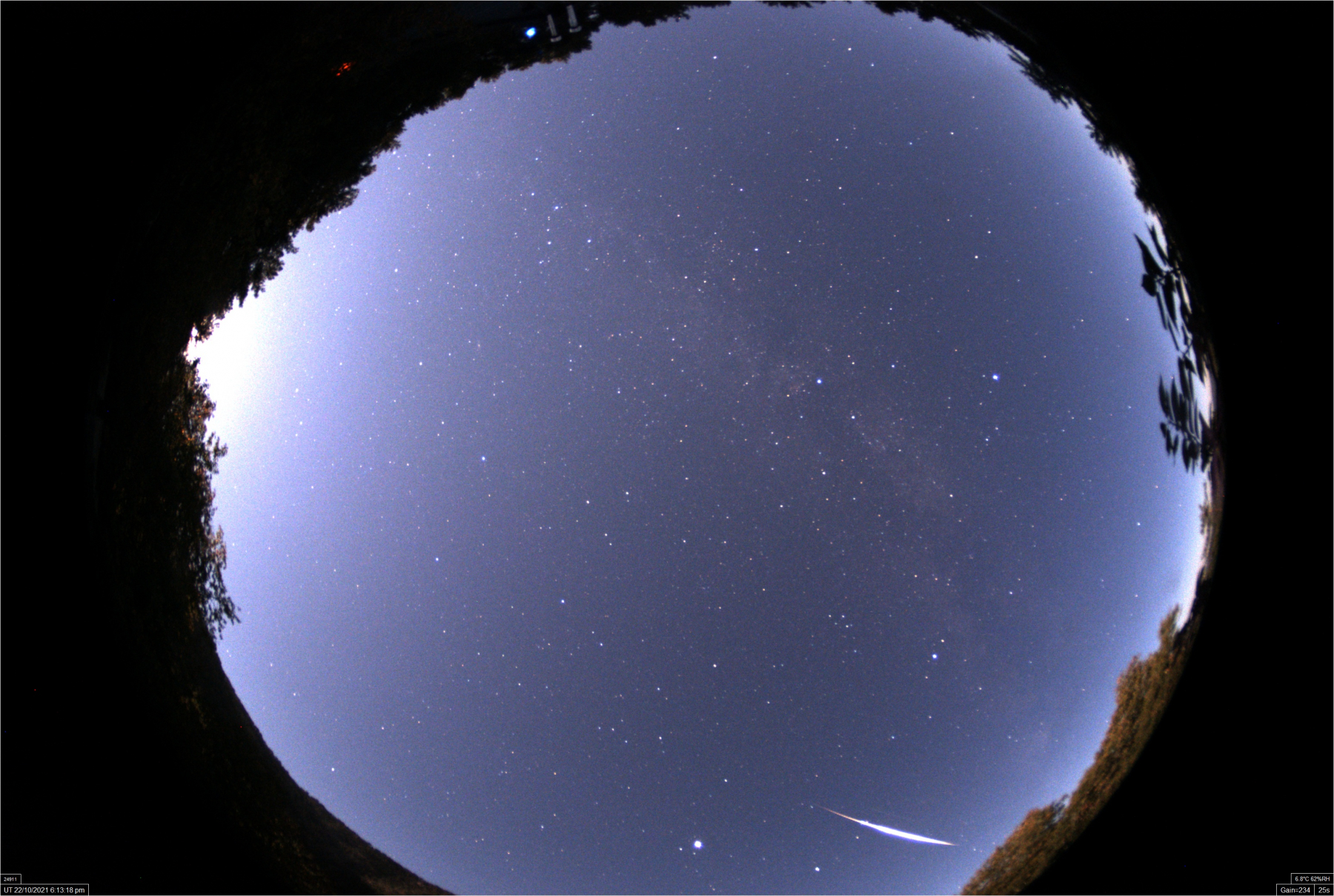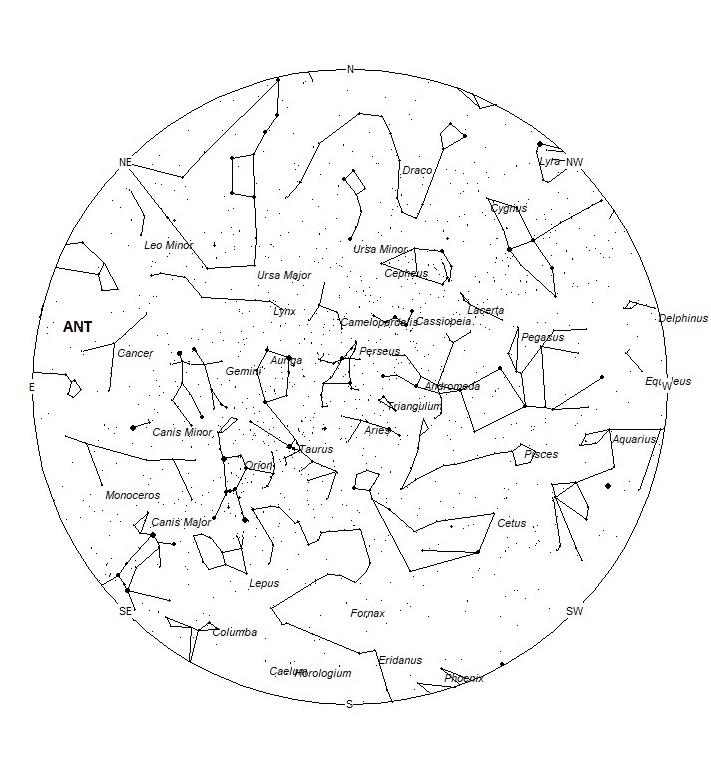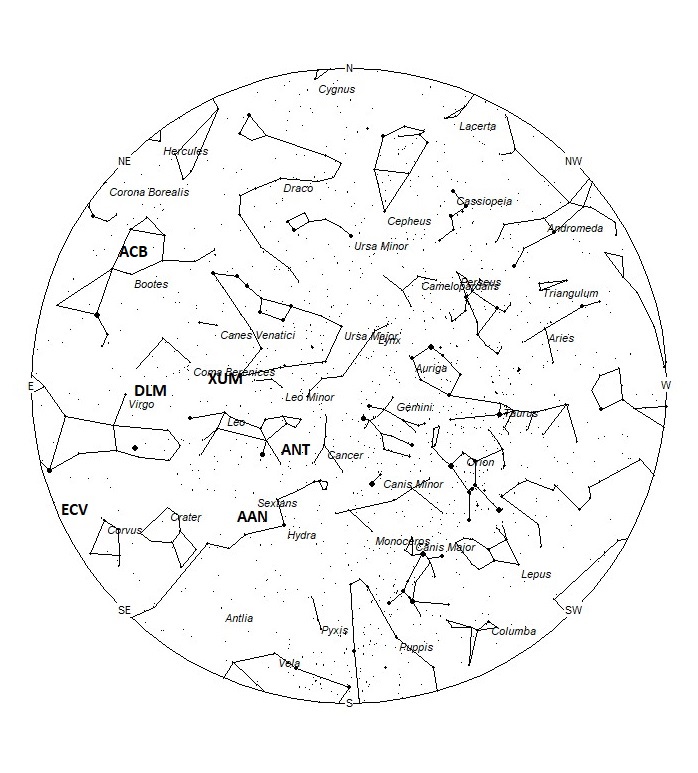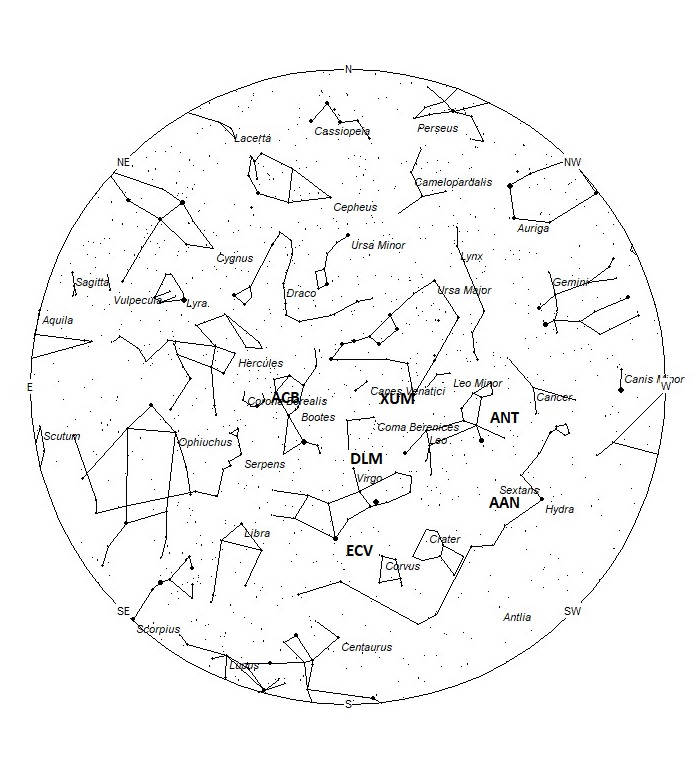 An all sky camera operated by Agapios Elia captured this fireball at 21:13 EEST (18:13 UT) on 22 October 2021 from Prodromos, Cyprus. Tracing the trail backwards reveals that this fireball could be a member of the Southern Taurids. ©Agapios Elia, 1010Asteroskopeion www.asteroskopeion.com
An all sky camera operated by Agapios Elia captured this fireball at 21:13 EEST (18:13 UT) on 22 October 2021 from Prodromos, Cyprus. Tracing the trail backwards reveals that this fireball could be a member of the Southern Taurids. ©Agapios Elia, 1010Asteroskopeion www.asteroskopeion.comDuring this period, the moon reaches its last quarter phase on Tuesday January 25th. At that time the moon lies 90 degrees west of the sun and rises near midnight. This weekend the waning gibbous moon will rise during the early evening hours, spoiling the sky with intense moonlight for the remainder of the night. The estimated total hourly meteor rates for evening observers this week is near 2 as seen from mid-northern latitudes (45N) and 2 as seen from tropical southern locations (25S). For morning observers, the estimated total hourly rates should be near 8 as seen from mid-northern latitudes (45N) and 6 as seen from tropical southern locations (25S). Morning rates during this period are reduced by moonlight. The actual rates will also depend on factors such as personal light and motion perception, local weather conditions, alertness, and experience in watching meteor activity. Note that the hourly rates listed below are estimates as viewed from dark sky sites away from urban light sources. Observers viewing from urban areas will see less activity as only the brighter meteors will be visible from such locations.
The radiant (the area of the sky where meteors appear to shoot from) positions and rates listed below are exact for Saturday night/Sunday morning January 22/23. These positions do not change greatly day to day so the listed coordinates may be used during this entire period. Most star atlases (available at science stores and planetariums) will provide maps with grid lines of the celestial coordinates so that you may find out exactly where these positions are located in the sky. I have also included charts of the sky that display the radiant positions for evening, midnight, and morning. The center of each chart is the sky directly overhead at the appropriate hour. These charts are oriented for facing south but can be used for any direction by rotating the charts to the desired direction. A planisphere or computer planetarium program is also useful in showing the sky at any time of night on any date of the year. Activity from each radiant is best seen when it is positioned highest in the sky, either due north or south along the meridian, depending on your latitude. It must be remembered that meteor activity is rarely seen at the radiant position. Rather they shoot outwards from the radiant, so it is best to center your field of view so that the radiant lies at the edge and not the center. Viewing there will allow you to easily trace the path of each meteor back to the radiant (if it is a shower member) or in another direction if it is sporadic. Meteor activity is not seen from radiants that are located far below the horizon. The positions below are listed in a west to east manner in order of right ascension (celestial longitude). The positions listed first are located further west therefore are accessible earlier in the night while those listed further down the list rise later in the night.
These sources of meteoric activity are expected to be active this week.
The large Anthelion (ANT) is currently centered at 09:04 (136) +20. This position lies in eastern Cancer, 4 degrees southeast of the 4th magnitude star known as Asellus Australis (delta Cancri). Due to the large size of this radiant, these meteors may also be seen from western Leo as well as Cancer. This radiant is best placed near 01:00 local standard time (LST) when it lies on the meridian and is highest in the sky. Rates at this time should be near 2 per hour as seen from the northern hemisphere and 1 per hour as seen from south of the equator. With an entry velocity of 30 km/sec., the average Anthelion meteor would be of slow velocity.
The alpha Antliids (AAN) were discovered by D. P. Galligan and W. J. Baggaley by using the Advanced Meteor Orbit Radar in New Zealand*. This very weak display is active from January 20 through February 10. There are two weak maximums occurring near January 26 and February 1. On January 26, the radiant lies at 10:02 (151) -06. This position lies in southwestern Sextans, 6 degrees southwest of the 4th magnitude star known as alpha Sextantis). I’m not certain why these meteors were called alpha Antliids as this position lies 20 degrees north of the constellation of Antlia. These meteors are best seen near 0200 LST when the radiant lies highest above the horizon. At 44 km/sec. the alpha Antliids produce meteors of medium velocity. Expected rates this week are less than 1 per hour no matter your location.
*Gary Kronk, Meteor Showers-An Annotated Catalog, 2nd Edition Page 45
The last of the January xi Ursae Majorids (XUM) are expected this week. This shower is active from January 10-25, with maximum activity occurring on the 19th. The radiant is currently located at 11:27 (172) +31, which lies in southern Ursa Major, 2 degrees east of the 4th magnitude star known as Alula Australis (xi Ursae Majoris). These meteors are best seen near 04:00 LST when the radiant lies highest above the horizon. Hourly rates should less than 1 no matter your location. These meteors encounter the atmosphere at 40 km/sec., which would produce meteors of average velocity.
The December Leonis Minorids (DLM) is a shower of long duration active from December 1st all the way through February 10th. Maximum occurred near December 19th when rates may have reached 3 an hour. During this period, I would expect hourly rates of less than one per hour from a radiant located at 12:48 (192) +15. This position lies in southern Coma Berenices just south of the faint star known as 27 Comae Berenices. These meteors are best seen near 0400 LST when the radiant lies highest above the horizon. At 63 km/sec. the December Leonis Minorids produce mostly swift meteors. These meteors are most commonly known as the Comae Berenicids.
The eta Corvids (ECV) were recently discovered by Sirko Molau and the IMO Video Meteor Network Team. This stream is active from January 7-February 5, with maximum activity occurring on January 21st. The current position of the radiant is 12:53 (193) -18, which places the radiant in eastern Corvus, 4 degrees east of gamma and eta Corvi. These meteors are best seen near 0500 LST when the radiant lies highest above the horizon. Current hourly rates would be less than 1 per hour no matter your location. At 68 km/sec. these meteors would be fast.
The alpha Coronae Borealids (ACB) were discovered by John Greaves using data from SonotoCo. Activity from this source spans from January 26 to February 5 with maximum activity occurring on January 27. The radiant is currently located at 15:11 (228) +31. This position lies in in eastern Bootes, 3 degrees southwest of the 3rd magnitude star known as Princeps (delta Bootis). These meteors are best seen during the last few hours before dawn, when the radiant lies highest in a dark sky. Current rates should be less than 1 per hour no matter your location. These meteors encounter the atmosphere at 55 km/sec., which would produce meteors of medium-swift velocity.
As seen from the mid-northern hemisphere (45N) one would expect to see approximately 10 sporadic meteors per hour during the last hour before dawn as seen from rural observing sites. Evening rates would be near 2 per hour. As seen from the tropical southern latitudes (25S), morning rates would also be near 10 per hour as seen from rural observing sites and 2 per hour during the evening hours. Locations between these two extremes would see activity between the listed figures. Evening rates are reduced by moonlight during this period.
You can keep track of the activity of these meteor showers as well as those beyond the limits of visual observing by visiting the NASA Meteor Shower Portal available at: https://meteorshowers.seti.org/ You can move the sky globe to see different areas of the sky. Colored dots indicate shower meteors while white dots indicate sporadic (random) activity. The large orange disk indicates the position of the sun so little activity will be seen in that area of the sky.
| SHOWER | DATE OF MAXIMUM ACTIVITY | CELESTIAL POSITION | ENTRY VELOCITY | CULMINATION | HOURLY RATE | CLASS |
| RA (RA in Deg.) DEC | Km/Sec | Local Standard Time | North-South | |||
| Anthelions (ANT) | — | 09:04 (136) +20 | 30 | 01:00 | 2 – 1 | II |
| alpha Antliids (AAN) | Jan 26 | 10:02 (151) -06 | 44 | 02:00 | <1 – <1 | IV |
| January xi Ursae Majorids (XUM) | Jan 19 | 11:27 (172) +31 | 40 | 04:00 | <1 – <1 | IV |
| December Leonis Minorids (DLM) | Dec 19 | 12:48 (192) +15 | 63 | 05:00 | 1 – <1 | II |
| eta Corvids (ECV) | Jan 21 | 12:53 (193) -18 | 68 | 05:00 | <1 – <1 | IV |
| alpha Coronae Borealids (ACB) | Jan 27 | 15:11 (228) +31 | 55 | 08:00 | <1 – <1 | IV |
 American Meteor Society
American Meteor Society



I seen something in the sky this past week. Speak right and then head to tail is hanging from it. Even seen it when night time came it’s bright like a star. Amazing because during the afternoon when I seen it it was it’s bright as the sun in the sky beautiful star.
Hi,
My name is Sibila Velasco, I am writing because I had a weird experience. I was driving on 36th NW and Lejune road with a friend, we were stopped at a red light, and all of a sudden she says do you see this? pointing in front of me but her voice was in disbelief. I look in the direction she was pointing and there was a meteor in front of me ( 01/08/22) at approximately 8:40 PM.
This looked so close to the Earth and was so fast that we could not put our phones out and took a pic or record. We have been searching and there is none reported on this day, would you please help me with some info for meteors that passed the Earth some dates and info? This meteor just disappears in front of our eyes, like to a whole or who knows what?!
Thank you